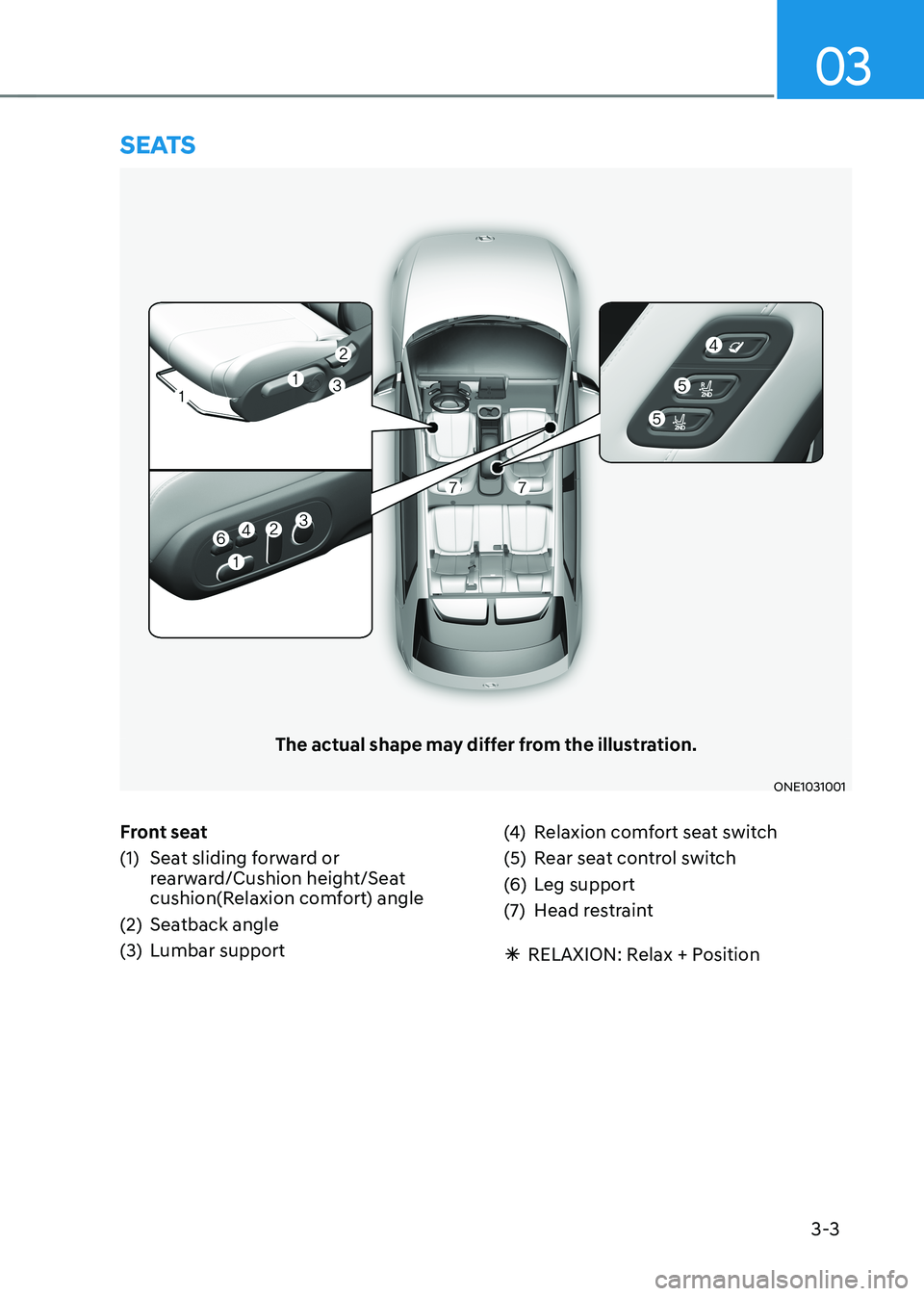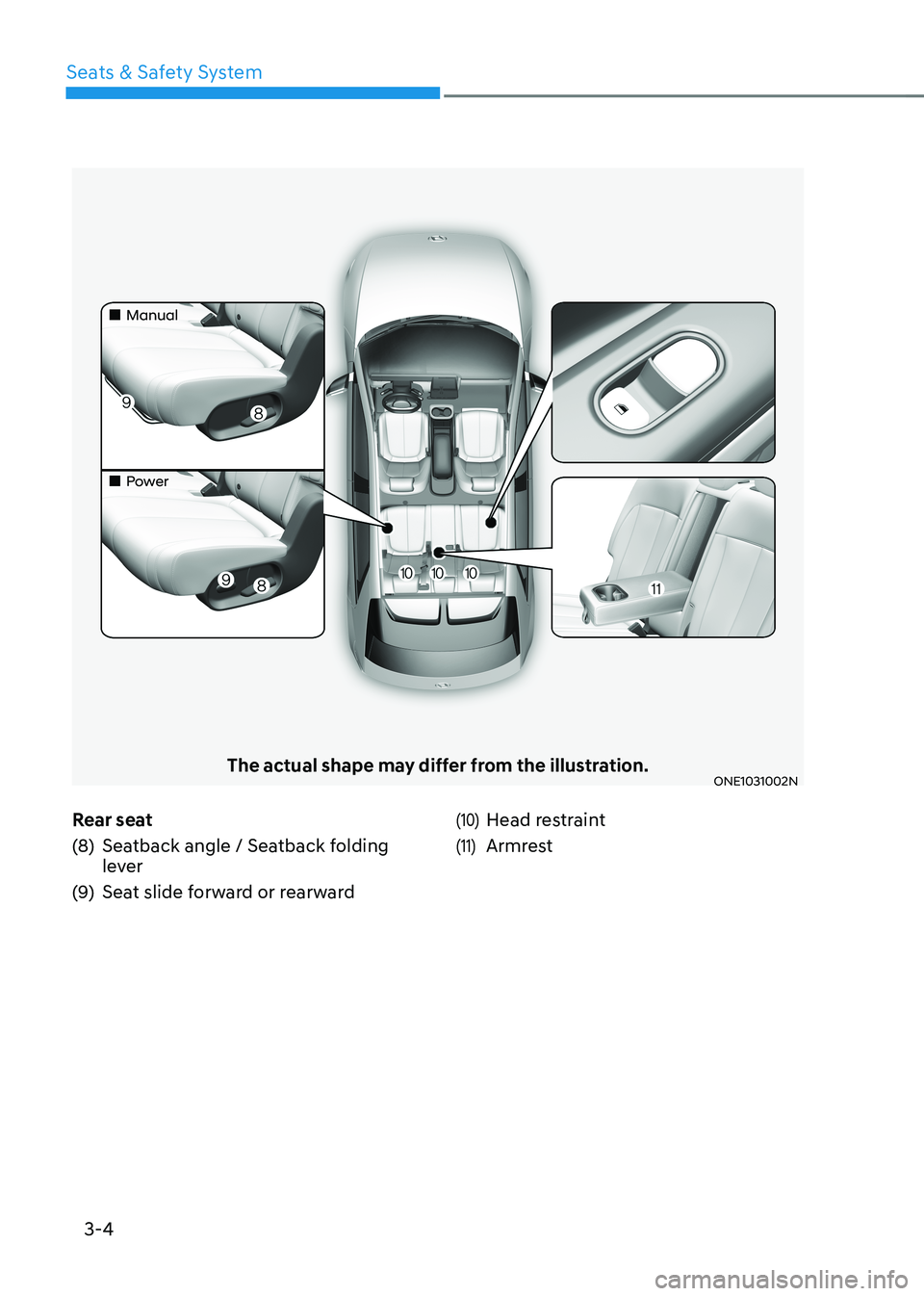2023 HYUNDAI IONIQ 5 rear seat
[x] Cancel search: rear seatPage 21 of 680

Foreword / Electric Vehicle System Overview
1-16
1. Connect to the power outlet located
in bottom of the rear seat with the
Vehicle Stop/Start button in the ON position.
ONE1Q011089
2. Use the smart key to unlock the power outlet cover.
ONE1Q011090
3. Check the operation status through the front indicator of the power outlet.
- Blue: Standby
- Red: No power supply even the power outlet is connected
- Green: Normal power supply through the normal connection of
the power outlet.
Information
• V2L discharging mode will shut off if
the vehicle is off using indoor V2L on the vehicle state of ON.
• Opening the charging door or
connecting the V2L connector to the
charging inlet, the V2L discharging mode will shut off. If you want to
use the indoor and outdoor V2L
simultaneously, firstly connect the V2L
connector to the charging inlet and use
the indoor V2L.
CAUTION
• Be well-informed of the manual to
prevent accidents.
• The V2L discharging mode is
blocked automatically in case of
overheating. (When the discharging
mode is blocked, check whether
the V2L connector or power plug
is contaminated, worn, corroded
or broken or the home appliance
capacity is over 16 A. If the
temperature falls to proper level
after it is left unattended, you can
use it again. Use proper home
appliances.)
• Do not remodel or disassemble
the provided V2L connector. The
failure caused by remodeling or
disassembling is not covered by the
warrant.
• Do not drop the V2L connector or
give a strong impact to it.
• Do not place objects on the V2L
connector.
• Be sure to disconnect the V2L
connector from the vehicle when you
are finished using V2L.
Page 75 of 680

2-5
02
1. Instrument cluster ..................................4-4
2. Horn ....................................................... 5-46
3. Driver’s front air bag .............................3-53
4. Infotainment system ...........................5-136
5. Hazard warning flasher button ..............8-2
6. Start/Stop button ................................... 6-4
7. Automatic climate control system .....5-102
8. Parking/View button ............................7-114
9. Parking Safety button ..........................7-134
10. Passenger’s front air bag ..................... 3-53 11. Glove box
............................................. 5-123
12. USB port ............................................... 5-135
13. Power outlet ......................................... 5-125
14. Cup holder ........................................... 5-124
15. USB charger ......................................... 5-126
16. Wireless charging system ...................5-127
17. Wireless charging system pad ............5-127
18. Center console..................................... 5-122
19. Rear seat USB charger ........................5-126
The actual shape may differ from the illustration.
ONE1011004
instrumEnt panEl ovErviEw (i)
Page 79 of 680

02
2-9
Light bulb Bulb type Wattage
FrontHeadlamp
Low
LED LED
High LED LED
Turn signal lamp STD:PY21W
OPT:LED STD:21W
OPT:LED
Position lamp LED LED
Daytime Running Lamp (DRL) LED LED
Side marker LED LED
Front garnish lamp LED LED
Front trunk lamp LED LED
Rear Stop lamp
LED LED
Tail lamp LED LED
Turn signal lamp LED LED
Reverse lamp STD : P21W
OPT : LED STD : P21W
OPT : LED
Side marker LED LED
License plate lamp LED LED
Fog lamp LED LED
High mounted stop lamp LED LED
Interior Front seat map and room lamp LED LED
Rear seat room lamp (without sunroof) LED LED
Rear seat personal lamp (with sunroof) LED LED
Vanity mirror lamp FESTOON 5W 5W
Glove box lamp
LED LED
Door mood lamp LED LED
Luggage compartment lamp FESTOON 10W 10W
BulB wattage
Page 88 of 680

3
3. Seats & Safety System
Important Safety Precautions ........................................................................... 3-2
Always Wear Your Seat Belt ......................................................................................... 3-2
Restrain All Children ..................................................................................................... 3-2
Air Bag Hazards ............................................................................................................ 3-2
Driver Distraction ......................................................................................................... 3-2
Control Your Speed ...................................................................................................... 3-2
Keep Your Vehicle In Safe Condition ........................................................................... 3-2
Seats .................................................................................................................. 3-3
Safety Precautions ....................................................................................................... 3-6
Front Seats .................................................................................................................... 3 -7
Rear Seats ................................................................................................................... 3-16
Head Restraint ............................................................................................................ 3-20
Seat Warmers ............................................................................................................. 3-24
Air Ventilation Seats ................................................................................................... 3-26
Advanced Rear Occupant Alert (ROA) ...................................................................... 3-28
Seat Belts ......................................................................................................... 3-29
Seat Belt Safety Precautions ..................................................................................... 3-29
Seat Belt Warning Light ............................................................................................. 3-30
Seat Belt Restraint System ......................................................................................... 3-31
Additional Seat Belt Safety Precautions ................................................................... 3-36
Care of Seat Belts ....................................................................................................... 3-38
Child Restraint System (CRS) ......................................................................... 3-39
Children Always in the Rear ....................................................................................... 3-39
Selecting a Child Restraint System (CRS) ................................................................3-40
Installing a Child Restraint System (CRS) .................................................................3-41
Air Bag - Supplemental Restraint System .....................................................3-49
Where are the Air Bags? ............................................................................................. 3-51
How does the Air Bags System Operate? .................................................................3-54
What to Expect After an Air Bag Inflates .................................................................. 3-58
Occupant Classification System (OCS) ..................................................................... 3-59
Why didn’t my air bag go off in a collision? ..............................................................3-65
SRS Care ..................................................................................................................... 3-70
Additional Safety Precautions .................................................................................... 3-71
Air Bag Warning Labels ............................................................................................... 3-71
Page 89 of 680

Seats & Safety System
3-2
You will find many safety precautions
and recommendations throughout this
section, and throughout this manual.
The safety precautions in this section are
among the most important.
Always Wear Your Seat Belt
A seat belt is your best protection in all
types of accidents. Air bags are designed
to supplement seat belts, not to replace
them. So even though your vehicle is
equipped with air bags, ALWAYS make
sure you and your passengers wear your
seat belts, and wear them properly.
Restrain All Children
All children under age 13 should ride
in your vehicle properly restrained in a
rear seat, not the front seat. Infants and
small children should be restrained in
an appropriate Child Restraint System.
Larger children should use a booster
seat with the lap/shoulder belt until they
can use the seat belt properly without a
booster seat.
Air Bag Hazards
While air bags can save lives, they can
also cause serious or fatal injuries to
occupants who sit too close to them, or
who are not properly restrained. Infants,
young children, and short adults are at
the greatest risk of being injured by an
inflating air bag. Follow all instructions
and warnings in this manual.
Driver Distraction
Driver distraction presents a serious and
potentially deadly danger, especially for
inexperienced drivers. Safety should be
the first concern when behind the wheel
and drivers need to be aware of the wide
array of potential distractions, such as
drowsiness, reaching for objects, eating,
personal grooming, other passengers, and using mobile phones.
Drivers can become distracted when
they take their eyes and attention off
the road or their hands off the wheel to
focus on activities other than driving.
To reduce your risk of distraction and an
accident: •
Set up your mobile devices (for
example, MP3 players, phones,
navigation units, etc.) ONLY when
your vehicle is parked or safely
stopped.
• ONLY use your mobile device when
allowed by laws and conditions permit
safe use. NEVER text or email while
driving. Most countries have laws
prohibiting drivers from texting. Some
countries and cities also prohibit
drivers from using handheld phones.
• NEVER let the use of a mobile device
distract you from driving. You have a
responsibility to your passengers and
others on the road to always drive
safely, with your hands on the wheel
as well as your eyes and attention on
the road.
Control Your Speed
Excessive speed is a major factor in crash
injuries and deaths. Generally, the higher
the speed, the greater the risk, but
serious injuries can also occur at lower
speeds. Never drive faster than is safe
for current conditions, regardless of the
maximum speed posted.
Keep Your Vehicle In Safe Condition
Having a tire blowout or a mechanical
failure can be extremely hazardous. To
reduce the possibility of such problems,
check your tire pressures and condition
frequently, and perform all regularly
scheduled maintenance.
Important safety precautIons
Page 90 of 680

3-3
03
Front seat
(1) Seat sliding forward or rearward/Cushion height/Seat
cushion(Relaxion comfort) angle
(2) Seatback angle
(3) Lumbar support (4)
Relaxion comfort seat switch
(5) Rear seat control switch
(6) Leg support
(7) Head restraint
à RELAXION: Relax + Position
seats
The actual shape may differ from the illustration.
ONE1031001
Page 91 of 680

3-4
Seats & Safety System
The actual shape may differ from the illustration.ONE1031002N
Rear seat
(8) Seatback angle / Seatback folding
lever
(9) Seat slide forward or rearward
(10) Head restraint
(11) Armrest
„
„Manual
„
„Power
Page 93 of 680

Seats & Safety System
3-6
Information
The information provided may differ
depending on which functions are
applicable to your vehicle.
Safety Precautions
Adjusting the seats so that you are sitting
in a safe and comfortable position plays
an important role for the safety of the
driver and passengers, as much as seat
belts and air bags when in an accident.
WARNING
Do not use a cushion that reduces
friction between the seat and the
passenger. The passenger’s hips may
slide under the lap portion of the seat
belt during an accident or a sudden
stop.
Serious or fatal internal injuries could
result because the seat belt cannot
operate properly. Air bags
You can take steps to reduce the risk
of being injured by an inflating air bag.
Sitting too close to an air bag greatly
increases the risk of injury in the event
the air bag inflates. Move your seat as
far back as possible from front air bags,
while still maintaining control of the
vehicle.
WARNING
To reduce the risk of serious injury or
death from an inflating air bag, take the
following precautions: • Adjust the driver’s seat as far to the
rear as possible maintaining the
ability to control the vehicle.
• Adjust the front passenger seat as far
to the rear as possible.
• Hold the steering wheel by the rim
with hands at the 9 o’clock and 3
o’clock positions to minimize the risk
of injuries to your hands and arms.
• NEVER place anything or anyone
between you and the air bag.
• Do not allow the front passenger to
place feet or legs on the dashboard
to minimize the risk of leg injuries.